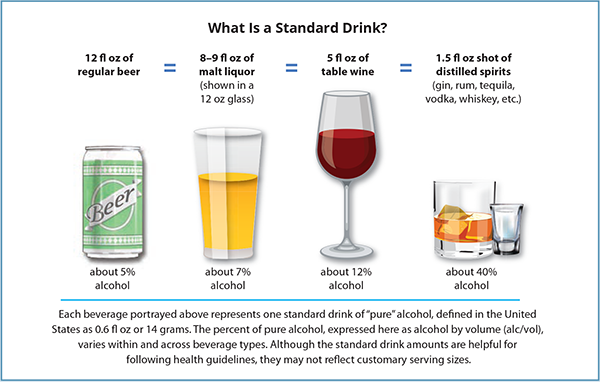5.7 Alcohol
Alcohol Facts and Statistics

Alcohol Use in Canada:
- Prevalence of Drinking: General population (age 15+): According to data collected from the 2017 Canadian Tobacco, Alcohol and Drugs Survey (CTADS), 78.2% of Canadians aged 15 and over reported drinking alcohol at least once in the last year. This level has remained relatively stable since 2013 (75.9%) (CCSA) Canada’s Guidance on Alcohol and Health: Final Report (Jan 2023)
- Prevalence of Binge Drinking and Heavy Alcohol Use: In 2018, 19.1% of Canadians aged 12 and older (roughly 5.9 million people) reported alcohol consumption that classified them as heavy drinkers.The proportion of people classified as heavy drinkers remained stable between 2017 and 2018 (19.5%, 19.1%).Overall, males were more likely (23.5%) to report heavy drinking than females (14.8%) in 2018. The highest proportion of heavy drinking for both sexes was among those aged 18 to 34. In this age group, 33.5% of males and 23.8% of females were heavy drinkers (Chart 1). Statistics Canada
Alcohol Use Disorder (AUD) in Canada:
- Adults (ages 18+): Approximately 21.6% of Canadians (about 6 million people) met the criteria for a substance use disorder during their lifetime (Table 1). Alcohol was the most common substance for which people met the criteria for abuse or dependence at 18.1% Statistics Canada
- Adults (65+): Alcohol is the most commonly used and misused substance among older adults (Kuerbis et al., 2014). Alcohol Use Disorder (AUD) and risky alcohol consumption is common among older adults, with reported problem drinking rates ranging from 1–22% (Woodruff et al., 2009). CCSMH
- Youth (ages 12–17): The overall prevalence of alcohol use in the past 12 months among students in grades 7–12 for 2016–2017 is 44.0%. 17 This rate is similar for males (44.2%) and females (43.8%) (Figure 3) (CCSA)(1) Canada’s Guidance on Alcohol and Health: Final Report (Jan 2023)
Alcohol-Related Deaths
- In 2014, alcohol contributed to 14,826 deaths in Canada, representing 22% of all substance use attributable deaths. CCSA
Economic Burden:
- In 2017, the rate of hospitalizations entirely caused by alcohol (249 per 100,000) was comparable to the rate of hospitalizations for heart attacks (243 per 100,000) and the rate was thirteen times higher than for opioids.
- Healthcare costs in Canada associated with the use of alcohol in 2014 were estimated to be 4.2 billion and accounted for 38% of all healthcare costs attributable to substance use.3 Healthcare costs include inpatient hospitalizations, day surgeries, emergency department visits, substance use treatment, family physician time and prescription drugs. Per-person healthcare costs associated with alcohol increased by approximately 25% from $95 per person in 2007 to $119 per person in 2014. CCSA
Brief Interventions with Alcohol Abuse Disorder
FRAMES Model
When working with brief interventions with Alcohol or Substance Abuse the FRAMES model is a great brief intervention that can be used in many different setting. It is very client-centred, non-judgemental, supportive that is a harm reduction strategy that is effective if the client is interested. It can be used in many different settings (outpatient or primary care settings) and in applied in many different ways, depending on the individual.
FRAMES stands for:
- provide Feedback about the persons drinking
- stress personal Responsibility for change
- provide clear Advice to cut down on drinking
- provide a Menu of options for reducing drinking
- use an Empathic approach in interacting with the client
- support Self-efficacy by enhancing beliefs about ability to change (Cunningham & Hodges, 2014, Outpatient Addiction Settings)
Global Burden:

- In 2012, 3.3 million deaths, or 5.9 percent of all global deaths (7.6 percent for men and 4.1 percent for women), were attributable to alcohol consumption.12
- In 2014, the World Health Organization reported that alcohol contributed to more than 200 diseases and injury-related health conditions, most notably DSM–IV alcohol dependence (see sidebar), liver cirrhosis, cancers, and injuries.13 In 2012, 5.1 percent of the burden of disease and injury worldwide (139 million disability-adjusted life-years) was attributable to alcohol consumption.12
- Globally, alcohol misuse was the fifth leading risk factor for premature death and disability in 2010. Among people between the ages of 15 and 49, it is the first.14 In the age group 20–39 years, approximately 25 percent of the total deaths are alcohol-attributable.15
Family Consequences:
- Approximately one in 10 Canadian children under the age of 12 lives with a parent with a substance use disorder according to a 2014 study CCSA
Underage Drinking:

- Prevalence of Underage Alcohol Use:
- Prevalence of Drinking: Close to 80% of young Canadians 15 years and older have reported drinking alcohol during the past year. It is the substance that the majority of young people in grades 7 through 12 will try first
- Prevalence of Binge Drinking and Heavy Alcohol Use: The overall prevalence of alcohol use in the past 12 months among students in grades 7–12 for 2016–2017 is 44.0%. 17 This rate is similar for males (44.2%) and females (43.8%)
- Consequences of Underage Alcohol Use: Whatever the reason, the younger the person is when they begin drinking, the higher the risk for poor health and problems related to alcohol consumption later in life.
- At higher risk for:
- blackouts
- alcohol poisoning
- developing or worsening depression
- anxiety & other mental health problems
- physically sick and possibly dying from alcohol poisoning
- getting into a fight or being assaulted
- unwanted sex or pushing unwanted sex on others
- suicide
- injured or killed while driving
- At higher risk for:
If you think a youth you know is dealing with addiction or drug-related issues, talk to them about it. If they don’t want to talk to you, provide them with other options such as:
- going with them to seek help from a doctor, counsellor, or other health care professional;
- sharing youth-appropriate information with them, that they can look at on their own time; or
- suggesting they contact Kids Help Phone (1-800-668-6868), a free, 24-hour anonymous professional telephone counselling and live chat service.
Dealing with alcoholism is never easy. If you think you are or someone close to you is suffering from an addiction to alcohol, you should talk about it with your parents, legal guardian, a friend, a teacher, a counsellor, a doctor or any other health care professional that will know how to help you. You can also call
- Kids Help Phone at 1-800-668-6868, where they can provide anonymous phone counselling.
The guidelines for consumption limits for Youth (with Parental Consent)
| Group
Youth
|
Limit alcohol to no more than:
|
Avoid Drinking Alcohol
|
For more information of Underage Drinking:
Alcohol and College Students:

- Prevalence of Alcohol Use:
- Prevalence of Drinking: In general, young adults consume substances at higher levels than the general population. In the past 12 months, 84% of students had consumed alcohol. Alcohol consumption in the past 12 months was higher among females and students in their third year or higher. majority of survey participants had consumed alcohol in their lifetime (88%), in the past 12 months (84%) and in the past 30 days (77%)
- Prevalence of Binge Drinking: Male respondents drank more frequently in the past 30 days. The proportion of males drinking once per week or more often was 46%, compared to 35% among females in the past 30 days. The most common response was spirits and liquors (69%), followed by beer (67%). In the past 30 days, 60% of respondents had consumed alcohol in a pattern consistent with heavy drinking. Among past-12 month drinkers, the proportion of students who reported driving within two hours of consuming at least two drinks was 9%, with males more likely to do so than females (12% males; 6% females). One in six (16%) of students reported ever being a passenger with a driver who had recently consumed alcohol.
- Prevalence of Heavy Alcohol Use: students who drank alcohol within the past 12 months, 56% had experienced at least one alcohol-related harm in the past month and the top five harms reported they experienced a hangover (33%), less energy or felt tired (25%), drank on nights when planned not to (22%), said or did something embarrassing (22%), or felt sick to their stomach or threw up (17%). 31% of all respondents experienced at least one harm within the past month as a result of another student’s drinking. five most commonly reported secondary harms were the need to take care of another student (14%), sleep was affected (13%), another student upset or disappointed them (11%), studies were interrupted (8%) another student caused an argument with them (7%).
Source: “Canadian Postsecondary Education Alcohol and Drug Use Survey, 2019/2020 Published:(2021-05-10)” by Government of Canada is in the Public Domain
For more information on Alcohol and College Students
Alcohol and Pregnancy

- Drinking alcohol during pregnancy can seriously harm an unborn baby. Each year in Canada, it is estimated that nine babies in every 1,000 are born with Fetal Alcohol Spectrum Disorder (FASD). The birth defects and developmental disabilities that result from FASD are preventable by avoiding alcohol during pregnancy Health Canada.
The guidelines for consumption limits for Pregnant Women
Alcohol and Women:

Women are generally more sensitive to the effects of alcohol than men, and all adults become increasingly sensitive to alcohol’s effects as they age. When someone is more sensitive, it takes less alcohol to cause intoxication and more time for the body to eliminate the alcohol consumed.
The guidelines for consumption limits for Women
| Group | Limit Alcohol to no more than: | Avoid Drinking Alcohol |
| Women |
|
on some days
|
| Group | Limit alcohol to no more than: | Avoid Drinking Alcohol |
| men |
|
on some days
|
Alcohol and the Human Body:

Definitions
Alcohol Use Disorder (AUD): AUD is a chronic relapsing brain disease characterized by an impaired ability to stop or control alcohol use despite adverse social, occupational, or health consequences. AUD can range from mild to severe, and recovery is possible regardless of severity. The fourth edition of the Diagnostic and Statistical Manual (DSM-IV), published by the American Psychiatric Association, described two distinct disorders—alcohol abuse and alcohol dependence—with specific criteria for each. The fifth edition, DSM-5, integrates the two DSM-IV disorders, alcohol abuse, and alcohol dependence, into a single disorder called alcohol use disorder, or AUD, with mild, moderate, and severe subclassifications.
Binge Drinking: CAMH says Researchers define binge drinking as having many drinks on one occasion: five or more drinks for a male, or four or more drinks for a female. A standard drink is defined as:
- 341 mL (12 oz.) beer, cider or cooler (5% alcohol)
- 142 mL (5 oz.) wine (12% alcohol)
- 85 mL (3 oz.) fortified wine (18% alcohol)
- 43 mL (1.5 oz.) liquor (40% alcohol)
Young people who binge drink are especially at risk. This is because they are less familiar with the effects of alcohol, and are more likely to do something impulsive or dangerous. Binge drinking is also more common among young people. Recent surveys show that:
- one-fifth (20%) of Ontario students in grades 7-12 report binge drinking at least once in the past month
- almost one in three (32%) Canadians between 20 and 34 years report binge drinking 12 or more times in the past year
- nearly one in five (19%) of Canadians between 35 and 44 years report binge drinking at this same rate.
Heavy Alcohol Use: SAMHSA defines heavy alcohol use as binge drinking on 5 or more days in the past month.
Moderate alcohol consumption: To reduce long-term health risks, Canada’s Low-Risk Alcohol Drinking Guidelines recommend: No more than 10 drinks a week for women, with no more than 2 drinks a day most days. No more than 15 drinks a week for men, with no more than 1 or 2 drinks a day most days for youth (with parental consent).
Definition of Drinking at Low Risk for Developing AUD: Low Risk Guidelines – CCSA
Alcohol-Impaired-Driving Fatality: A fatality in a crash involving a driver or motorcycle rider (operator) with a BAC of 0.08 g/dL or greater
In Ontario’s zero tolerance law for young, novice and commercial drivers, you cannot have any alcohol in your system if you are: age 21 or under Ontario’s zero tolerance law for young, novice and commercial drivers, you cannot have any alcohol in your system if you are: age 21 or under
Disability-Adjusted Life-Years (DALYs): A measure of years of life lost or lived in less than full health.
Underage Drinking: 18 years of age in Alberta, Manitoba and Quebec, and 19 years in the rest of the Canadian provinces and territories
Resource: RCMP – Alcohol
What Is A Standard Drink/How do you know how much alcohol is in your drink?
A standard drink is a measure of how much pure alcohol you are drinking. It varies based on the concentration of alcohol in a beverage.
In Canada, a standard drink is 17.05 millilitres or 13.45 grams of pure alcohol. This is the equivalent of:
- a bottle of beer (12 oz., 341 ml, 5% alcohol)
- a bottle of cider (12 oz., 341 ml, 5% alcohol)
- a glass of wine (5 oz., 142 ml, 12% alcohol)
- a shot glass of spirits (1.5 oz., 43 ml, 40% alcohol)

Low-risk Alcohol Drinking Guidelines – Government of Canada
Heavy drinking, by age group
| Geography | Canada (excluding territories)3 | |||
|---|---|---|---|---|
| Sex | Both sexes | |||
| Indicators | Heavy drinking6 | |||
| Characteristics5, 7, 8, 9, 10, 11, 12, 13 | Number of persons | Percent | ||
| Age group | 2019 | 2020 | 2019 | 2020 |
| Total, 12 years and over | 5,802,200 | 5,320,500 | 18.3 | 16.6 |
| 12 to 17 years | 62,100 | 66,500 | 2.7 | 2.8 |
| 18 to 34 years | 2,249,300 | 1,885,900 | 26.9 | 22.4 |
| 35 to 49 years | 1,595,900 | 1,522,000 | 22.2 | 21.0 |
| 50 to 64 years | 1,414,000 | 1,368,600 | 18.8 | 18.1 |
| 65 years and over | 480,900 | 477,500 | 7.6 | 7.4 |
Canada’s low-risk alcohol drinking guidelines
Canada’s Low-Risk Alcohol Drinking Guidelines can help you make informed decisions about drinking. The guidelines recommend setting limits to help you reduce the acute (short-term) and chronic (long-term) health risks of alcohol use.
It is important to keep in mind that:
- the intention of these guidelines is not to encourage people who abstain (for cultural, spiritual, health or other reasons) to start drinking
- these are “low-risk” guidelines, not “no-risk” guidelines. Any amount of alcohol consumption can have risks to your health
Visit the following websites for information on alcohol
Specialized Programs for Alcohol – Government of Canada
The Health Portfolio plays an important role in addressing alcohol-related harm. A number of initiatives are aimed at reducing alcohol misuse among Canadians, such as:
- Fetal alcohol spectrum disorder: About, causes and co-occurring conditions
- https://www.canada.ca/en/health-canada/services/health-concerns/drug-prevention-treatment/canadian-alcohol-drug-use-monitoring-survey.html
- Government of Canada – National Native Alcohol and Drug Abuse Program (NNADAP)
- First Nations Health Authority – Health through Wellness
- Developing an Indigenous approach to FASD
- Preventing FASD through Providing Addictions treatment and related support For First Nations and Inuit Women in Canada
Economic Burden caused by Alcohol Abuse in Canada
Attribution:
Drugs, Health & Behavior by Jacqueline Schwab and Denise Salters is licensed under a Creative Commons Attribution-NonCommercial-ShareAlike 4.0 International License, with Canadian Content
References
Figure 5.7.8 – Government of Canada. (2021a, July 5). Low-risk Alcohol Drinking Guidelines. Government. Retrieved April 5, 2022, from https://www.canada.ca/en/health-canada/services/substance-use/alcohol/low-risk-alcohol-drinking-guidelines.html
Mattoo, S. K., Prasad, S., & Ghosh, A. (2018). Brief intervention in substance use disorders. Indian journal of psychiatry, 60(Suppl 4), S466–S472. https://doi.org/10.4103/0019-5545.224352

